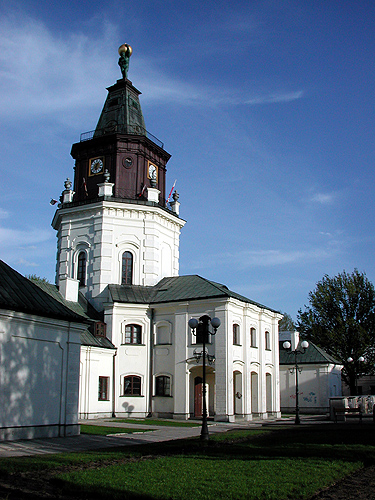City tour - architectural monuments

Visiting the city is the best to start with the town hall located in the city center, built in 1763-1766, probably according to the design of Jan Zygmunt Deybel. The current town hall was built on the site of several existing wooden town halls, destroyed by fires.
Built on a cross plan, it is a typical example of the town hall. Spacious wings were intended for shops and administrative rooms occurred in the tower part, located centrally. The town hall is not stylishly homogeneous. The lower parts of the building have late baroque architecture features, the tower bears rococo features, and its upper storey and finial are characterized by calmer classicist forms. On the tower there is a figure of Atlas - Jack (Jacek) carrying the globe. According to legend, an equerry of Princess Aleksandra, whose name was Jacek, posed to the sculpture. A clock with chimes playing the polonaise "Farewell to the Fatherland" by Kleofas Ogiński was placed on the town hall tower. Currently, the town hall is the seat of the Regional Museum.
Church of St. Stanislaus
On the opposite side of Floriańska Street, in front of the town hall, stands the baroque-classicist church of St. Stanislaus. Founded by prince Kazimierz Czartoryski, the castellan of Vilnius and his wife Izabella née Morsztyn, it was built in 1740-49. Built in the eastern frontage of the market square, it was the first stone church in Siedlce which replaced the existing wooden church. The facade was added by architect Stanisław Zawadzki in 1793 at the expense of Aleksandra Ogińska. The basilica interior has three naves. Two-story facade, in the lower floor, a Tuscan portico on which the balcony rests. In the church, paintings of four evangelists from the Ossolinski collection, located in the presbytery, deserve the attention. In the side altars there are paintings of Szymon Czechowicz.
The closest surrounding of the church is a late baroque presbytery with a beautiful mansard roof and a projection on the axis topped with a tympanum. It was built in 1768-1774, probably according to the design of Jan Zygmunt Deybel. Around 1781, during the reconstruction of the palace, it was the seat of Aleksandra Ogińska. In the nineteenth century, it was the seat of the Tribunal and the post office.
From J. Piłsudski street at the church of St. Stanislaus there are fragments of the former belfry gate. The city gate had the shape of a triumphal arch with three arcades. It was built in 1773-76 at the expense of Aleksandra Ogińska and was demolished in 1941 by the Germans because it hindered the movements of vehicles and the army to the east.
Oginski Palace
At Kościuszki Street, a short distance from the church, there is a palace-classicist magnate residence. It was built on the place of a wooden manor by Prince Kazimierz Czartoryski before 1730. His granddaughter Duchess Aleksandra Ogińska rebuilt the palace in the years 1776-1782 according to the design by architect Stanisław Zawadzki. The palace received a classical style and interior layout.
In the eighteenth century, the palace was visited by King Stanisław August Poniatowski, on whose arrival a Tuscan column was erected (at the street ul. Sokołowska), topped with a baroque cross. The column still indicates access to the palace's honorary courtyard.
The palace was also visited by representatives of eminent families - Branicki, Potocki, national heroes - Tadeusz Kościuszko and poets of the Enlightenment era - Julian Ursyn Niemcewicz, Franciszek Karpiński, Franciszek Kniaźnin. After the death of Aleksandra Ogińska, the palace together with the Siedlce estate became the property of the government and since then it has become a public facility. In 2001, the building was handed over to the university in Siedlce which gave it a thorough renovation, financed in the large part from the EU funds. Currently, it houses the office of Rector of the University of Natural Sciences and Humanities.
Alexandria Park
The palace was adjacent to a park founded in the 18th century by the Czartoryski family as an Italian garden. After taking over the estate, Duchess Ogińska changed its appearance and around 1768 arranged a sentimental park with wild groves, flower beds, winding roads and canals with numerous islands. There were more than thirty different buildings in it such as: the duchess's residential houses, gazebos, bathrooms, fishing house, Turkish mosque, orangery, stable, windmill and others. In the nineteenth century, both gardens - Italian and English ones - were transformed into an existing city park till today.
Chapel of Saint Cross – at the street ul. Starowiejska
The last of the monuments related to the Ogiński family is located at the street ul. Starowiejska, the chapel of St. Cross, erected according to the design of Zygmunt Vogel in 1791. It was built as a palace chapel at the place of the first church. Classicist, octagonal, covered with a dome, topped with an openwork lantern. On three sides it is decorated with porticos with Tuscan columns. From the east side, above the entrance to the tomb crypt of Aleksandra Ogińska, a portico with a broken column and the monogram of A.O. are visible. On the main door, there are lion-head door knockers from the end of the 18th century. Inside there is a frontal embroidered by hand probably by A. Ogińska with her initials.
Cathedral
The monument worth seeing, despite its less than a century of history, is the cathedral in Siedlce. Built in 1905-1912 according to the design of Zygmunt Zdański, a governorate architect, on the Latin cross plan, three-nave, in the neo-Gothic style. The monumental church, with its characteristic towers visible within a radius of a few kilometers from the city, was built in accordance with the principles and proportions of the Middle Ages. Stained glass windows destroyed and rebuilt after World War II, depict the history of the church in Poland and Podlasie.
Post office
At the street ul. J. Piłsudski, there is a classicist building, erected according to the design of Antonio Corazzi in 1827-28, at the place of the former inn at the Brest Route. During the times of Aleksandra Ogińska, meals for the poor were delivered there, nowadays it is the seat of the post office. In the former tavern, Alexander Orłowski, a future battle painter spent his youth at the place, whose capabilities were noticed by Duchess Aleksandra and helped him to develop.
One of the outstanding architectural objects of Siedlce is the tenement building at the street ul. Floriańska 5. Built at the end of the 19th century, it was bought by the Orthodox church which established an orphanage there. Currently, it is the property of St. Stanislaus church. The tenement building in an eclectic style combines elements of the Renaissance, Baroque and Classicism.














